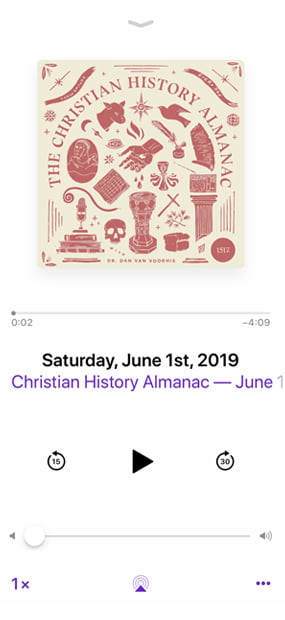Monday, October 6, 2025
Today on the Christian History Almanac, we remember St. Bruno the Carthusian on his feast day.
It is the 6th of October 2025. Welcome to the Christian History Almanac brought to you by 1517 at 1517.org. I'm your guest host, Sam Leanza Ortiz.
Happy Monday, everyone. I hope you enjoyed your weekend, because you’re stuck with me for one more week while Dan is away. Today’s show has a little bit of everything: medieval monasticism, corrupt bishops, and rare liqueurs.
We head back to the 11th century to remember St. Bruno, the founder of the Carthusian order.
Bruno was born in Cologne, Germany, around 1030, probably to a well-off family that was able to support a good education. He was ordained in 1057 and called to Reims, France, to lead the cathedral school and the schools of the diocese. One of his students would go on to become Pope Urban II, who called for the First Crusade in 1095.
At Reims, Bruno climbed the clerical ranks, becoming the chancellor of the church in 1075, but then, things went south.
The recently installed archbishop, Manasses de Gournai, had a low reputation for harsh language and a reported distaste for saying the mass. When a community of nearby monks sought to install a new abbot, the situation between them and the archbishop devolved such that the archbishop excommunicated the monks, prompting the pope to get involved.
Bruno, as chancellor, was in daily contact with the archbishop, and as his conduct grew worse, Bruno protested the things he witnessed, which caused him to lose his position and flee the city.
By 1080, just a few years later, the pope would depose Archbishop Gournai, and Bruno would be presented as a successor to the see, but in his years away from Reims, Bruno’s intentions for his life had changed. Rather than grow in rank and responsibility, he would forsake the world and take up orders.
It’s not clear when the journey started, but by 1084, Bruno and six companions would be led by the bishop of Grenoble to a deserted area called Chartreuse in the French Prealps, which sits to the west of the French Alps. There, these seven men would build a monastery and establish the Carthusian order.
The Carthusian order derives its name from its location in Chartreuse, and as an order, it would follow, but modify the Benedictine Rule of the sixth century.
Carthusian monks follow a semi-eremitic life, meaning they spend most of their time in silence and solitude, but gather together for vigils, vespers, and matins as well as a meal together on Sundays.
The goal of this is contemplation that is separate from the world, to be emptied of oneself and be filled with God Himself.
After 6 years of pursuing this contemplation, Bruno would once again resist rejoining the world as his former student, Pope Urban II would suggest him for the archbishopric of Reggio, Italy, down in Calabria, Italy’s toe.
Instead of going back to the church, Bruno obtained permission to return to the monastic life.
Rather than returning to Chartreuse, Bruno established the second Carthusian community in Santa Maria della Torre, among the arid deserts of the Italian south.
Bruno spent his remaining years in this semi-eremitic community, dying on the 6th of October, in 1101.
The Carthusian order has been in continuous operation since Bruno's death, with more monasteries popping up over the years. Communities of Carthusian nuns would develop later that century.
Bruno’s sainthood would take some time, as he would not be beatified until 1514, and his canonization would not be until 1623.
Starting in the eighteenth century, the monks would come out with perhaps their most well-known feature – a greenish-yellow liqueur known popularly today as Chartreuse, the recipe for which comes from centuries of herbal and medicinal studies and experimentation.
Today, they still make Chartreuse as there are 21 active Carthusian houses around the world, with over 350 monks and nuns, continuing the tradition started by Saint Bruno, whose feast day we commemorate on this, the 6th of October.
The last word for today comes from the daily lectionary, from James 2:
2 Consider it pure joy, my brothers and sisters,[a] whenever you face trials of many kinds, 3 because you know that the testing of your faith produces perseverance. 4 Let perseverance finish its work so that you may be mature and complete, not lacking anything. 5 If any of you lacks wisdom, you should ask God, who gives generously to all without finding fault, and it will be given to you. 6 But when you ask, you must believe and not doubt, because the one who doubts is like a wave of the sea, blown and tossed by the wind. 7 That person should not expect to receive anything from the Lord. 8 Such a person is double-minded and unstable in all they do.
9 Believers in humble circumstances ought to take pride in their high position. 10 But the rich should take pride in their humiliation—since they will pass away like a wild flower. 11 For the sun rises with scorching heat and withers the plant; its blossom falls and its beauty is destroyed. In the same way, the rich will fade away even while they go about their business.
This has been the Christian History Almanac for the 6th of October 2025, brought to you by 1517 at 1517.org.
This show has been produced by Christopher Gillespie.
This show has been written and read by Sam Leanza Ortiz, filling in for Dan van Voorhis, who finds Chartreuse an impossible color to pull off.
You can catch us here every day- and remember that the rumors of grace, forgiveness, and the redemption of all things are true…. Everything is going to be ok.

Subscribe to the Christian History Almanac
Subscribe (it’s free!) in your favorite podcast app.